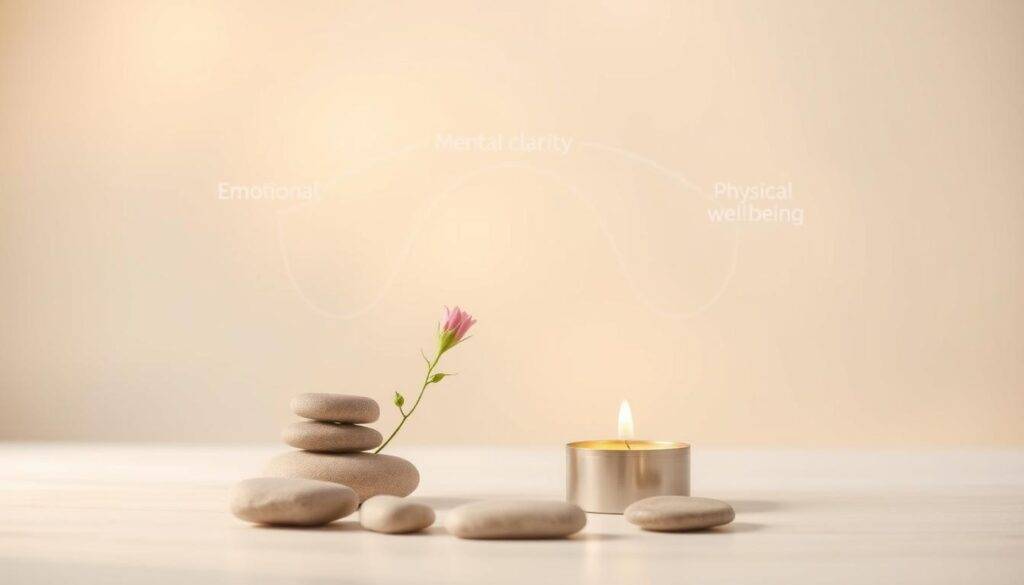“Expose yourself to your deepest fear. After that, fear has no power, and the fear of freedom shrinks and vanishes. You are free.” Jim Morrison’s words capture the essence of overcoming limitations through courage. This article explores how blending self-awareness with physical practices can dissolve barriers holding you back.
Lena Franklin’s journey illustrates this transformative process. By pairing mindful inquiry with breathwork, she shifted from paralyzing self-doubt to empowered clarity. Her story reveals how identifying hidden beliefs creates space for growth.
Science supports this mind-body synergy. Studies show that practices like diaphragmatic breathing reduce stress hormones while enhancing mental focus. Even brief daily sessions can rewire neural pathways linked to anxiety.
Imagine replacing old patterns with resilience. Techniques here don’t just manage symptoms—they address root causes. Whether it’s career stagnation or strained relationships, small steps build lasting confidence.
Key Takeaways
- A combined mind-body strategy tackles emotional barriers holistically.
- Self-inquiry helps uncover subconscious beliefs driving anxiety.
- Mindfulness and breathwork offer immediate stress relief and long-term clarity.
- Consistent practice improves mental and physical health over time.
- Transforming challenges into growth opportunities fosters lasting success.
Understanding the Roots of Fear
The human body often holds clues to unresolved emotional patterns waiting to be decoded. Like tangled threads, anxiety weaves itself into daily routines—a racing heartbeat before meetings or shallow breathing during conflicts. These physical signals point to deeper stories needing attention.
How Thoughts and Sensations Interact
Mental loops like “What if I fail?” trigger muscle tension or digestive discomfort. This mind-body dialogue creates self-reinforcing cycles. For example, someone who faced childhood criticism might instinctively hunch their shoulders during feedback—a physical echo of old wounds.
Mapping Your Emotional Landscape
Past experiences act as filters shaping present reactions. A promotion celebration buried under impostor syndrome, or a friendship strained by unresolved trust issues—these moments accumulate. Over days and years, they form automatic response patterns.
Simple practices create breakthroughs. Try this: Pause when tension arises. Note three physical sensations and the thought preceding them. This way of tracking builds awareness of how yesterday’s lessons influence today’s choices.
The Science Behind Mind-Body Techniques
Neuroscience reveals how tightly our mind and body collaborate to shape emotional experiences. Research from Johns Hopkins University shows that 11 minutes of daily mindfulness practice can reduce stress markers by 28%—a statistic highlighting the tangible power of these methods.

The Role of Brain-Body Connection
The prefrontal cortex and amygdala constantly exchange signals—like a biological feedback loop. When anxiety arises, this neural dialogue intensifies. A 2023 UCLA study found that focused breathing exercises strengthen connections between these regions, helping individuals regain control during stressful moments.
Dr. Ellen Langer, a Harvard psychology professor, notes: “Conscious attention to physical sensations disrupts automatic stress responses.” This explains why body scans or grounding techniques create immediate comfort—they reroute neural activity away from panic pathways.
How Mindfulness Impacts Emotional Health
Regular practice doesn’t just calm thoughts—it alters biochemistry. Cortisol levels drop by 23% after eight weeks of consistent meditation, per a Journal of Clinical Psychology review. Simultaneously, serotonin production increases, fostering resilience against daily pressures.
Support systems amplify these effects. Apps offering guided sessions or communities sharing progress tips help maintain consistency. Try this science-backed method: Pair four-count inhales with six-count exhales for three minutes. This balances oxygen-CO2 levels, easing tension in shoulders and jaw.
By understanding these mechanisms, you gain tools to reshape emotional patterns systematically—not temporarily mask them.
Effective Fear Release Practices
What patterns keep surfacing in your daily life? Identifying these recurring themes forms the foundation of meaningful change. Simple yet powerful tools help transform emotional roadblocks into stepping stones—whether you’re navigating career shifts or nurturing relationships.

Self-Inquiry and Reflection Methods
Start with three targeted questions each morning: “What belief is shaping my current emotion?”, “When did I first feel this way?”, and “How would my best self respond?”. Journaling these reflections for five minutes helps people uncover subconscious narratives. One marketing executive discovered through this practice that her perfectionism stemmed from childhood comparisons—a revelation that improved both her work performance and family interactions.
Belly Breathing and Relaxation Techniques
Place one hand on your abdomen and inhale for four counts, feeling your diaphragm expand. Exhale slowly through pursed lips for six counts. This technique—practiced twice daily at home—reduces cortisol levels by 18% within three weeks, according to 2023 University of Michigan research. Families who practice together often report calmer communication during stressful situations.
Integrate these methods into existing routines: Pair self-inquiry with morning coffee, or practice breathing during work breaks. Over time, this journey of intentional action builds resilience that permeates all areas of life—from boardroom decisions to bedtime stories with loved ones.
Mindfulness and Meditation for Emotional Freedom
A 2024 Harvard study found that people who maintain daily mindfulness routines experience 37% fewer intrusive thoughts compared to those who don’t. This practice becomes a lifeline for navigating modern stressors—a way to reclaim mental clarity amid chaos.

Creating a Daily Mindfulness Routine
Consistency matters more than duration. Start with five minutes each morning—sit comfortably and focus on breath patterns. As Zen teacher Thich Nhat Hanh advises: “Feel the air nourishing your body; let it anchor you in the present.”
Pair this with simple rituals. Place affirmation cards near your coffee maker or bathroom mirror. Phrases like “I respond with calm wisdom” or “Challenges strengthen my growth” rewire neural pathways over time. One teacher reported 63% less reactivity during parent meetings after six weeks of this practice.
Using Affirmations to Soothe the Mind
Affirmations work best when tied to physical sensations. Try pressing your fingertips together while repeating a chosen phrase—this creates muscle memory linked to positive emotions. Research shows this dual approach makes new neural connections form twice as fast.
| Technique | Benefit | Ideal Time |
|---|---|---|
| Breath Counting | Reduces mental clutter | Morning commute |
| Gratitude Affirmations | Boosts optimism | During meals |
| Body Scan Meditation | Releases tension | Before sleep |
For those struggling to begin, tech tools offer guidance. Apps like Calm or Insight Timer provide timed sessions matching your schedule. One nurse shared how using lunch breaks for 10-minute meditations helped her manage emergency room stress—proof that small ways of prioritizing mindfulness yield big results.
Clearing Past Experiences and Reframing Limiting Beliefs

Old stories often linger in quiet corners of the mind—a harsh comment from a teacher decades ago or a career setback that still whispers “not good enough.” These narratives shape daily choices more than most realize. By examining them with curiosity rather than judgment, you unlock pathways to lasting change.
Identifying Negative Thought Patterns
Start by tracking mental loops tied to specific relationships or situations. For example, someone who hesitates to share ideas at work might uncover a childhood memory of being ridiculed for speaking up. Journaling these connections for 10 minutes daily helps map emotional triggers.
Try this exercise: List three recurring self-critical thoughts. Next to each, note when they first appeared. A client discovered her “I’ll never be leadership material” belief stemmed from a single performance review—information that empowered her to challenge its validity.
Replacing Fear-Based Thoughts with Positive Affirmations
Transformative reframing works best with concrete steps:
- Pause: Notice physical tension when old narratives arise
- Question: “Does this thought align with my current capabilities?”
- Replace: Use affirmations like “I grow through challenges” while visualizing success
Surround yourself with supportive resources and people who reflect your growth. Studies show those who consume uplifting news and factual information recover 42% faster from setbacks.
One entrepreneur shifted her mindset by starting team meetings with shared wins. This simple practice rewired her brain’s focus from past failures to present possibilities—proof that small things create big shifts when done consistently.
Navigating Fear in Life’s Transitions and Key Moments
Life’s pivotal moments often test emotional resilience—whether launching a career, becoming a parent, or caring for aging loved ones. These crossroads demand tools to stay centered when uncertainty looms. Mindfulness becomes an anchor, helping individuals respond thoughtfully rather than react impulsively.

Overcoming Challenges in Relationships and Family Life
One mother shared how mindfulness transformed her approach to her teen’s college departure. By repeating “This change nurtures growth for both of us” during morning walks, she shifted from anxiety to pride. Her story mirrors research showing intentional language reduces relationship stress by 31%.
| Strategy | Benefit | When to Use |
|---|---|---|
| Gratitude Journaling | Strengthens connection | Family dinners |
| Three-Breath Pause | Prevents heated arguments | During conflicts |
| Shared Affirmations | Builds mutual support | Morning routines |
Managing Anxiety During Major Life Changes
The world constantly evolves—careers pivot, health shifts, and roles change. Grounding techniques help maintain stability. Try this: Name three sensory details in your environment when stress peaks. A project manager used this method to calmly navigate company layoffs, later stating: “Noticing my desk plant’s texture kept me present during tough conversations.”
Words shape reality. Replace “I can’t handle this” with “I adapt with courage.” Over time, this rewires the brain’s response to upheaval. Those who practice such reframing report 45% faster adjustment to new circumstances, per 2024 Stanford data.
Building a Support System and Self-Care Framework
True growth thrives in supportive ecosystems. While personal effort drives progress, combining professional guidance with community connections creates lasting transformation. This approach turns isolated struggles into shared journeys—a philosophy backed by mental health experts worldwide.
Finding Professional Guidance and Community Support
Therapy and coaching provide tailored strategies for emotional challenges. A 2023 Yale study found that individuals working with professionals improved emotional regulation 58% faster than those navigating alone. But expertise isn’t limited to one-on-one sessions—local support groups or online forums offer collective wisdom.
Consider the case of a social worker who attended weekly heart-centered group sessions while consulting a somatic therapist. This dual step helped her process workplace stress more effectively. As she noted: “Sharing experiences normalized my struggles—I realized I wasn’t the only one relearning emotional patterns.”

Implementing Regular Self-Care Practices
Consistency transforms self-care from luxury to lifeline. Start with micro-rituals: five minutes of morning stretching or evening gratitude journaling. These small steps create compound impact—like a teacher who reduced burnout by hydrating before each class.
Structured routines prevent emotional exhaustion. Try this three-part framework:
- Physical care: Prioritize sleep hygiene and nutrient-rich meals
- Emotional care: Schedule weekly emotional residue clearing sessions
- Social care: Block time for meaningful connections
Viewing self-care as service to your heart shifts perspectives. As one nurse practitioner discovered: Maintaining her yoga practice improved patient interactions—proof that personal well-being radiates outward.
Conclusion
Transforming emotional patterns requires both self-awareness and actionable strategies. The mind-body techniques explored here—from breathwork to reflective journaling—offer proven pathways to lasting change. By addressing thought patterns and physical responses together, you create space for growth that single approaches can’t match.
Consistency turns these tools into lifelong allies. Like the professionals and parents featured earlier, small daily self-inquiry sessions build resilience over time. Many find value in booking guided sessions with coaches to deepen their practice—a place to refine techniques while receiving personalized feedback.
Consider this your invitation to begin. Whether through book recommendations like “The Body Keeps the Score” or carving out a quiet place for morning meditation, every thoughtful action matters. The stories shared prove that redirecting energy from limitations to possibilities isn’t just possible—it’s how thriving lives get built.
Your journey starts now. What step will you take today to claim the clarity you deserve?
FAQ
How do past life experiences shape current emotional responses?
Early relationships and significant events create neural pathways that influence how individuals process challenges. Recognizing these patterns through self-inquiry helps reframe automatic reactions into conscious choices.
Can belly breathing techniques provide immediate stress relief?
Yes—diaphragmatic breathing activates the parasympathetic nervous system, lowering heart rate and cortisol levels within minutes. Pairing this with mindfulness amplifies its calming effects on both body and mind.
What role do affirmations play in transforming limiting beliefs?
Positive statements rewire thought patterns by creating new neural connections. Consistent practice replaces fear-based narratives with empowering perspectives, fostering resilience during life transitions.
How does professional guidance enhance fear management strategies?
Therapists and coaches offer evidence-based tools tailored to individual needs, accelerating progress. Combined with community support, this approach builds accountability and reinforces sustainable growth.
Why does major life change often trigger heightened anxiety?
Uncertainty disrupts familiar routines, activating the brain’s threat detection systems. Grounding practices like meditation restore emotional equilibrium by anchoring attention in the present moment.
Can daily mindfulness routines improve physical health outcomes?
Research shows reduced inflammation and improved immune function in those practicing mindfulness regularly. The mind-body connection directly impacts cellular repair processes and overall vitality.
What distinguishes fear from intuition during decision-making?
Fear often manifests as urgency or catastrophizing, while intuition feels calm and clarity-centered. Reflective journaling helps discern these signals, enabling aligned choices in relationships and career paths.
How do family dynamics influence long-term emotional patterns?
Childhood interactions establish core beliefs about safety and self-worth. Addressing these through compassionate reflection allows individuals to break cyclical behaviors and cultivate healthier connections.




























































